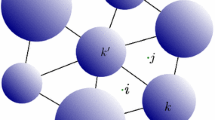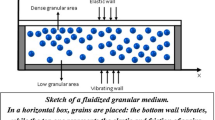Abstract
Gravitational instabilities occurring at the interface between a suspension of granular particles and a clear fluid are studied experimentally using a sealed Hele–Shaw cell. Special attention is paid to the effects of particle Reynolds number (Re) and the initial particle packing on the growth of the interfacial perturbation. Glass beads are immersed in the glycerin–water mixture and are placed at the bottom of the cell initially. The mass content of the glycerin in fluid mixtures is varied to obtain the desired fluid viscosities and thus the Re value. The cell is then inverted to place the suspension above the fluid to trigger the gravitational instabilities. When the particle packing is dense, the distinct interface separating the fluid transforms progressively into an asymmetrical cusp-shaped structure. In contrast, when the packing is loose, the interface between the fluid and suspension takes on a symmetrical sinusoidal form initially and evolves into a mushroom-like pattern reminiscent of the canonical Rayleigh–Taylor instability. The growth rate of this symmetrical perturbation observed for loose packing surpasses that of its asymmetrical counterpart at the equivalent Re. Both types of perturbations exhibit larger growth rates with increasing Re. Linear stability analysis adapted to the loose packing configuration predicts a growth rate that is comparable to the observed rate during the initial growth of the symmetrical perturbation and suggests a similar dependence on Re.



















Similar content being viewed by others
Availability of data and materials
The data that support the findings of this study are available within the article.
References
Bowman DT, Warren LA, McCarry BE et al (2019) Profiling of individual naphthenic acids at a composite tailings reclamation fen by comprehensive two-dimensional gas chromatography-mass spectrometry. Sci Total Environ 649:1522–1531
Burns P, Meiburg E (2012) Sediment-laden fresh water above salt water: linear stability analysis. J Fluid Mech 691:279–314
Burns P, Meiburg E (2015) Sediment-laden fresh water above salt water: nonlinear simulations. J Fluid Mech 762:156–195
Chandrasekhar S (1961) Hydrodynamic and hydromagnetic stability. Oxford University Press, London
Cheng NS (2008) Formula for the viscosity of a glycerol-water mixture. Ind Eng Chem Res 47(9):3285–3288
Chou YJ, Shao YC (2016) Numerical study of particle-induced Rayleigh–Taylor instability: effects of particle settling and entrainment. Phys Fluids 28:043302
Chou YJ, Wu FC, Shih WR (2014) Toward numerical modeling of fine particle suspension using a two-way coupled Euler–Euler model: part 2: simulation of particle-induced Rayleigh–Taylor instability. Int J Multiph Flow 64:44–54
Chou YJ, Cheng CJ, Chern RL et al (2019) Instabilities of particle-laden layers in the stably stratified environment. Phys Fluids 31(12):124101
Einstein A (1906) Eine neue bestimmung der moleküldimensionen. Ann Phys 324(2):289–306
Gibson RE, Schiffman RL, Cargill KW (1981) The theory of one-dimensional consolidation of saturated clays. II. Finite nonlinear consolidation of thick homogeneous layers. Can Geotech J 18(2):280–293
Guazzelli E, Morris J (2011) A physical introduction to suspension dynamics. Cambridge University Press, Cambridge
Guo J (2021) Direct simulations of fluid-particle flow in Newtonian and non-Newtonian fluids using coupled lattice Boltzmann and discrete element methods. Ph.D. thesis, University of Calgary
Guo J, Zhou Q, Wong RCK (2022) Evolution of Rayleigh–Taylor instability at the interface between a granular suspension and a clear fluid. Phys Fluids 34(7):073304
Kobayashi KU, Kurita R (2022) Key connection between gravitational instability in physical gels and granular media. Sci Rep 12:6290
Krieger IM, Dougherty TJ (1959) A mechanism for non-Newtonian flow in suspensions of rigid spheres. Trans Soc Rheol 3:137–152
Kull H (1991) Theory of the Rayleigh–Taylor instability. Phys Rep 206(5):197–325
Lange A, Schröter M, Scherer MA et al (1998) Fingering instability in a water-sand mixture. Eur Phys J B 4:475–484
Mikaelian KO (1993) Effect of viscosity on Rayleigh–Taylor and Richtmyer–Meshkov instabilities. Phys Rev E 47:375–383
Mingotti N, Woods AW (2019) Multiphase plumes in a stratified ambient. J Fluid Mech 869:292–312
Mingotti N, Woods AW (2020) Stokes settling and particle-laden plumes: implications for deep-sea mining and volcanic eruption plumes. Phil Trans R Soc A 378(2179):20190532
Niebling MJ, Flekkøy EG, Måløy KJ et al (2010) Mixing of a granular layer falling through a fluid. Phys Rev E 82(1):011301
Niebling MJ, Flekkøy EG, Måløy KJ et al (2010) Sedimentation instabilities: impact of the fluid compressibility and viscosity. Phys Rev E 82(5):051302
Pan TW, Joseph DD, Glowinski R (2001) Modelling Rayleigh–Taylor instability of a sedimenting suspension of several thousand circular particles in a direct numerical simulation. J Fluid Mech 434:23–37
Roberts M, Jacobs J (2016) The effects of forced small-wavelength, finite-bandwidth initial perturbations and miscibility on the turbulent Rayleigh–Taylor instability. J Fluid Mech 787:50–83
Vinningland JL, Johnsen Øistein, Flekkøy EG et al (2007) Experiments and simulations of a gravitational granular flow instability. Phys Rev E 76:051306
Vinningland JL, Johnsen O, Flekkøy EG et al (2007) Granular Rayleigh–Taylor instability: experiments and simulations. Phys Rev Lett 99:048001
Vinningland JL, Johnsen O, Flekkøy EG et al (2010) Size invariance of the granular Rayleigh–Taylor instability. Phys Rev E 81:041308
Völtz C (2003) Granular dynamics of density profiles in a suspension interface. Phys Rev E 68:021408
Völtz C, Schröter M, Iori G et al (2000) Finger-like patterns in sedimenting water-sand suspensions. Phys Rep 337:117–138
Völtz C, Pesch W, Rehberg I (2001) Rayleigh–Taylor instability in a sedimenting suspension. Phys Rev E 65:011404
Wells MG, Dorrell RM (2021) Turbulence processes within turbidity currents. Annu Rev Fluid Mech 53(1):59–83
Yu Z, Wu C, Berrouk A et al (2015) Discrete particle modeling of granular Rayleigh–Taylor instability. Int J Multiph Flow 77:260–270
Zhou Y (2017) Rayleigh–Taylor and Richtmyer–Meshkov instability induced flow, turbulence, and mixing. I. Phys Rep 720–722:1–136
Zhou Y (2017) Rayleigh–Taylor and Richtmyer–Meshkov instability induced flow, turbulence, and mixing. II. Phys Rep 723–725:1–160
Acknowledgements
This work was supported by funding from the Natural Sciences and Engineering Research Council of Canada (NSERC). The technical advice for image recording and processing from Dr. Jiaheng Xie is gratefully acknowledged. The computational resources required for data processing were provided in part by the Digital Research Alliance of Canada.
Funding
Funding for this work was provided by the Natural Sciences and Engineering Research Council of Canada (NSERC).
Author information
Authors and Affiliations
Contributions
The experiments were primarily conducted by J.G., with assistance from all other authors. J.G. and Q.Z. wrote the main manuscript text and prepared the figures. All authors reviewed and approved the manuscript.
Corresponding author
Ethics declarations
Conflict of interest
The authors declare no competing interests.
Ethical approval
Not applicable.
Additional information
Publisher's Note
Springer Nature remains neutral with regard to jurisdictional claims in published maps and institutional affiliations.
Appendix: Late-time processes following the instabilities
Appendix: Late-time processes following the instabilities
Representative snapshots for the experiment with \(\text {Re}=7.3\times 10^{-3}\) and dense packing (\(M>0.99\)) subsequent to those shown in Fig. 7
In Fig. 20 in this appendix, we illustrate the progression of flow within the Hele–Shaw cell following the destruction of the initial suspension-fluid boundary. Figure 20a duplicates the final snapshot presented in Figs. 7, and 20b–f showcase the ensuing processes. Specifically, in Fig. 20b, the dilute fluid ‘bubble’ reaches the upper boundary of the cell; by Fig. 20c, a distinct gap emerges between the suspension and the top wall due to material depletion within this top layer. Throughout Fig. 20d–f, the process of hindered settling continues, leading to further consolidation of the material and a growing height of clear fluid layer within the cell.
Rights and permissions
Springer Nature or its licensor (e.g. a society or other partner) holds exclusive rights to this article under a publishing agreement with the author(s) or other rightsholder(s); author self-archiving of the accepted manuscript version of this article is solely governed by the terms of such publishing agreement and applicable law.
About this article
Cite this article
Guo, J., Zhou, Q., Zhang, Y. et al. Experimental investigation of gravitational instabilities at the particle suspension-fluid interface. Exp Fluids 65, 43 (2024). https://doi.org/10.1007/s00348-024-03784-2
Received:
Revised:
Accepted:
Published:
DOI: https://doi.org/10.1007/s00348-024-03784-2





